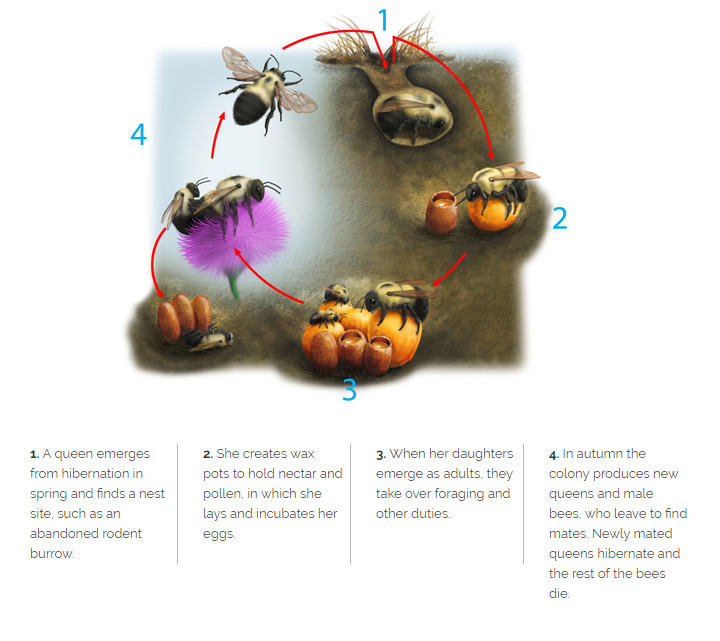Welcome to DU!
The truly grassroots left-of-center political community where regular people, not algorithms, drive the discussions and set the standards.
Join the community:
Create a free account
Support DU (and get rid of ads!):
Become a Star Member
Latest Breaking News
Editorials & Other Articles
General Discussion
The DU Lounge
All Forums
Issue Forums
Culture Forums
Alliance Forums
Region Forums
Support Forums
Help & Search
About Bumble Bees [View all]

Bumble Bee populations across America have fallen off drastically however there are some
simple things that you can do to help out this extremely important native pollinator. Give
'em food (native plants), water, habitat, and limit you use of insecticides and one person,
or one school, or one business can help our friend "the Bombus."
https://www.smithsonianmag.com/smart-news/american-bumblebee-has-vanished-from-eight-us-states-180978817/
BTW joining and supporting the Xerces Society is good way to help to support all of our "little
critter friends." E.O. Wilson, "The Little Things that Run The World."
************
All bumble bees belong to the genus Bombus within the family Apidae. The family Apidae includes the well-known honey bees and bumble bees, as well as carpenter bees, cuckoo bees, digger bees, stingless bees, and orchid bees. Bumble bees are important pollinators of wild flowering plants and crops. As generalist foragers, they do not depend on any one flower type. However, some plants do rely on bumble bees to achieve pollination. Loss of bumble bees can have far ranging ecological impacts due to their role as pollinators. In Britain and the Netherlands, where multiple bumble bee and other bee species have gone extinct, there is evidence of decline in the abundances of insect pollinated plants. Bumble bees are also excellent pollinators of many crops.
Nesting
Bumble bees are the only bees native to North America that are truly social. They live in colonies, have different divisions of labor or castes, and have overlapping generations, usually with multiple broods throughout the spring, summer, and fall. However, unlike the non-native, European honey bees, the bumble bee colony has an annual life cycle. At the end of the summer the foundress queen, her workers and male offspring will all die; only the newly emerged, fertilized queens (gynes) survive to hibernate through the winter. In the spring, she will found a new nest that eventually may grow, depending on the species and available resources, to 50 – 500 individuals. Bumble bees need a cavity in which to build their nest. The queens are opportunists, looking for any suitably sized cavity. Sometimes this is above ground, such as in hollow trees, abandoned bird nests, rock walls, or under a tussock of grass, but they mostly nest underground. An abandoned rodent hole is a favorite, as this space is warm and already lined with fur.
snip
Foraging
Bumble bees are generalist feeders, often the first bees active in late winter (February) and the last in fall (November). Since they are active for so many months, they must be able to forage on a wide range of plant species in a wide range of weather conditions to support a colony. Early season, and late season resources are critical, as these are sensitive times of the year for successful establishment, and reproduction. Some individual bees in the colony choose to forage exclusively on a single species or a limited range of related plant species, effectively becoming specialist foragers. When foraging, the female bumble bee carries pollen in a concave, hairless area surrounded by stiff hairs on her rear legs, known as the pollen basket or corbicula. This basket can be seen clearly when it is empty—and, when full, the pollen ball pressed into it is obvious.
Pollination
Bumble bees are able to fly in cooler temperatures and lower light levels than many other bees, and they perform a behavior called “buzz pollination,” in which the bee grabs the pollen producing structure of the flower in her jaws and vibrates her wing musculature. This causes vibrations that dislodge pollen that would have otherwise remained trapped in the flower’s anthers. Some plants—including tomatoes, peppers, and cranberries—benefit significantly from buzz pollination. In contrast to European honey bees, who make large amounts of honey so the entire colony can survive the winter, bumble bees only make a small amount of honey—just enough to feed the colony for a couple of days during bad weather. Since newly-mated bumble bee queens hibernate, they do not need the vast quantity of honey found in honey bee hives.
https://xerces.org/bumblebees/about

12 replies
 = new reply since forum marked as read
Highlight:
NoneDon't highlight anything
5 newestHighlight 5 most recent replies
= new reply since forum marked as read
Highlight:
NoneDon't highlight anything
5 newestHighlight 5 most recent replies
You don't need to keep honey bees to have good pollination .... native pollinators (wasps, bees, ...
Botany
Oct 2021
#6
Round up doesn't really work on thistle. It just burns the plant and maybe the top few inches of ..
Botany
Oct 2021
#9